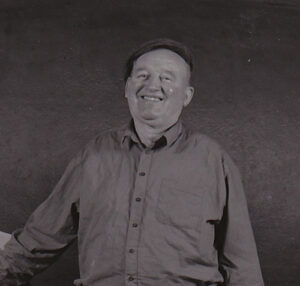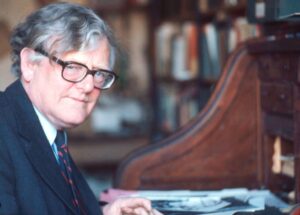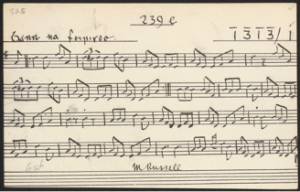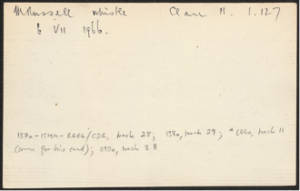



The Irish Traditional Music Archive (ITMA) is committed to providing free, universal access to the rich cultural tradition of Irish music, song and dance. If you’re able, we’d love for you to consider a donation. Any level of support will help us preserve and grow this tradition for future generations.
Last February, we embarked on a placement opportunity at the Irish Traditional Music Archive (ITMA) as part of our Master of Arts in Musicology and Performance programme at Maynooth University (Co. Kildare). We are three postgraduate students. Two of us, Lina María Manjarrés and Tyler Wallin, are specialising in performance, whereas Marina Cabrera is taking the musicological path. We were offered the opportunity to delve deep into the world of Irish traditional music and explore the lives and legacies of some of its most influential figures. In this five-week placement we have learned how a music archive works and also received training from Treasa Harkin, Librarian, and Maeve Gebruers, Archivist, on various tasks such as scanning, managing databases, and transcribing music, among many other duties.
In this article, we will describe our experience working in ITMA and carrying on with our assigned project, which was focused on preserving the music of Micho Russell. For that, we used a collection of handwritten transcriptions of jigs, reels and other tunes by Micho Russell curated by collector Breandán Breathnach. Our mission was to scan those handwritten notes, updating them into ITMA’s database and finally transcribing the music into a musical software so it could be uploaded into the ITMA website for everyone to access.
Before we started on the project, we needed to understand more about Micho Russell and Breandán Breathnach, so using ITMA’s library collection we were able to comprehend on a deeper level the importance of the work we were about to do.

Micho Russell
Originally from Co. Clare, Micho Russell was a flute and tin whistle player. Being one of the most praised figures in Irish traditional music, he was musically influenced by family members such as his father, a sean-nós singer. Due to Doolin’s remoteness at the time, Micho did not have access to technological advances such as the gramophone; however, because of this same reason he was able to be in close contact with the local repertoire, in particular to flute player John Darcy. Together with his brothers, Micho used to perform at house dances and pubs, and thanks to the revival of Irish traditional music in the 1960s, he found a way to develop his musical career in Dublin. This led to the opportunity to perform on radio and TV stations, expanding the reach of his music nationwide.
In 1973 Micho won the All-Ireland whistle championship, which allowed him to perform outside Ireland in the following years. In terms of his musical style, it has a certain ‘fresh’ and neat style, without having too many ornaments. An interesting fact about his performances is that he used to enjoy sharing the tales and lore behind his tunes, as he used to do with tunes such as ‘John Philip Holland’ and ‘The well of spring water’, which made the audience engage on a deeper level with Micho’s music.

As we mentioned earlier on the article, Micho’s music was collected by Breandán Breathnach (1912-1985), a prominent 20th-century Irish musicologist, who left a significant impact on the musical history of Ireland. He is mostly known for hismonumental work Folk Music and Dances of Ireland (1971), a comprehensive collection that catalogues and documentsIrish traditional music. His dedication to compiling and preserving these cultural expressions critically contributed to the understanding and conservation of Ireland’s musical heritage. Breandán not only gathered melodies but also documented valuable historical and social contexts, offering a complete insight into Ireland’s rich musical tradition. His work remains an essential reference for musicians, scholars, and enthusiasts of Irish traditional music, solidifying his legacy as a pioneering and vital advocate for his country’s musical heritage.
After researching these two relevant figures, we found ourselves quite excited to fulfil the archive’s expectations, as well as ours, with this project. This opportunity felt like an incredibly vast new world for us as early professional performers and musicologists. With the guidance of well qualified staff in ITMA, in particular Maeve Gebruers, we were efficiently taught how to perform all the relevant tasks in the most structured manner possible. We commenced our placement with a tour of ITMA given by librarian Treasa Harkin. We learned more about the contents of the library, the collections it holds and the inner workings of a musical archive. We then spent time familiarising ourselves with ITMA’s archival database and other resources needed for the project.
The main purpose of the project was to preserve the work of Micho Russell and provide his music to other researchers and music enthusiasts in an easily-accessible manner. The primary source that we were dealing with consisted of index cards of handwritten tune transcriptions from Micho Russell’s performances, created and annotated by Breandán Breathnach. Then, once the tasks need for our project were explained in more detail, we chose to approach these challenges by compartmentalising the tasks within our team of three.
Firstly, one member would focus on scanning the primary source cards using a professional overhead scanner, which provided us with very detailed and high-quality images of the documents. This involved learning the essential functions of the scanner, including the necessary precautions and the proper procedure to do this operation. Managing this task also required the careful handling of the index cards, ensuring they were correctly uploaded to the computer. We needed to maintain a meticulous order and cleanliness as we extracted them from their box, where they had been organised.


Scanned version of the front and back of card #825
During this process, another team member would take on the task of matching each card with an already existing audio file. This track would be found in the ITMA archive, where we also searched for other related data in order to match the correct audio and information with each scan of the cards’ collection. The remaining person would be responsible for documenting in detail all the tasks that were being performed so that we could write down this article later on as part of our final assignment for our master’s degree course, but also, as part of our placement with ITMA.
We rotated the tasks, so that each of us could try to each side of the project. The second half of the placement consisted of turning the scans into PDF/As, a format commonly used in archives and similar to the standard PDF, the difference being that it allows for long-term preservation of the document. This process took place in one of the offices on the third floor, leaving for a while the partially dark scanning room. This task demanded a certain automotive skill and intense concentration mainly due to the large number of scans that we had to deal with.
Finally, using the PDF/As, we started transcribing as many tunes as possible into a musical notation software. We had to decide as a group how to undertake some of the annotations in the cards, deciding between the three of us how to digitally represent the tunes in the most truthful way possible. Then, the transcriptions were uploaded to the official ITMA website, allowing access to musicians and to anyone interested in preserving and spreading the music and work of Micho Russell and Breandán Breathnach, not only to current enthusiasts, but also for the many generations to come.
One of our transcriptions is published below. It is an interactive score of tune #825, The Munster buttermilk, jig. In this format it is easy to learn the tune. The software can slow down or speed up the tune, loop through sections, display the ABC, change the key or change the instrument.
As a group, we collectively agreed that the internship at the Irish Traditional Musical Archive has been exceptionally enriching. Through our commitment to the preservation of these primary sources by Micho Russell, we contributed to the preservation of very valuable material and made it accessible to those interested in playing, learning, or researching about this relevant figure in Irish traditional music.
In essence, digital stewardship ensures that materials such as these will be accessible for future generations, international demographics, and those with varying technological skills. This placement was not only educational but also let us step out of our comfort zone and learn to adapt our knowledge into different projects outside our university campus. Although our joyous experience was sadly short-lived, the experience was remarkably fruitful, emphasising the positive impact it had on our personal and professional growth.
Lina María Manjarrés, Tyler Wallin & Marina Cabrera, April 2024
Sources
Coady, Michael, The Well of Spring Water: A Memoir of Packie and Micho Russell of Doolin, (The Galery Press, 1996), pp. 26-40
Vallely, Fintan, The Companion to Irish Traditional Music, (Cork: Cork University Press, 1999), pp. 39-40 & 324-325
Winter, Dennis C., Doolin’s Micho Russell: A portrait, (New York: Canal Press, 1990)